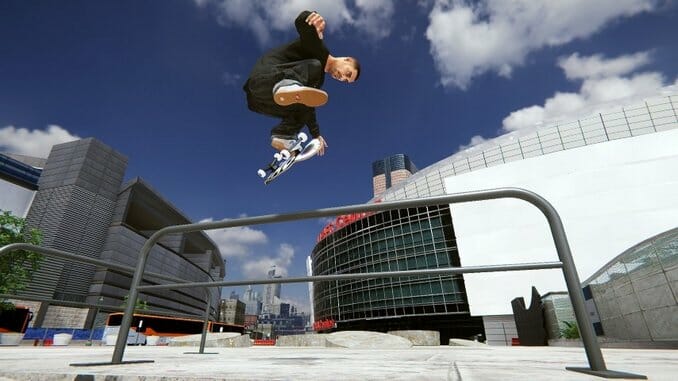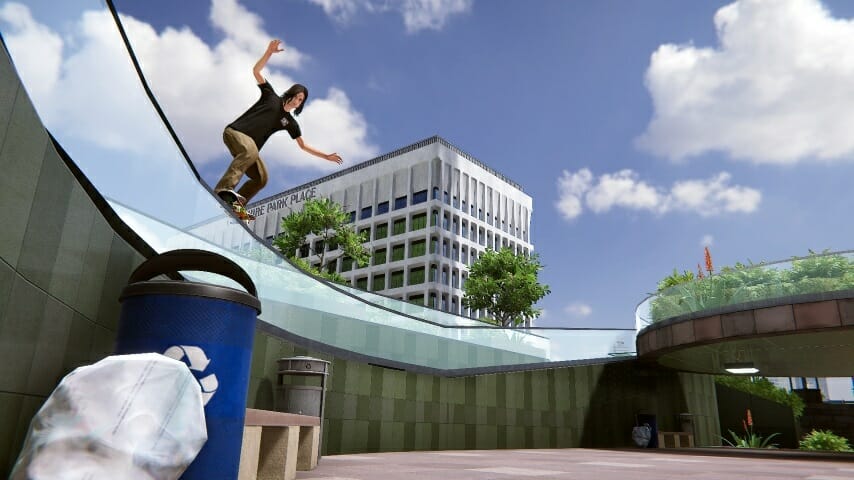Skater XL Is a Living History of Skating and a Love Letter to Skate Videos

There is no better sound than hearing the cobblestone sidewalk click under the wheels of my skateboard. I’m barreling towards the crooked handrail that I am going to frontside noseslide down, and there is nothing else going on in my mind: just my skateboard beneath my feet, the many ways I could bail if I don’t place my board just right on the rail, and how my fingers will manipulate the analog sticks to make this trick happen. Yes, I am talking about a videogame: Skater XL, the newest “big(ish) and realistic” skateboarding game since Skate 3 in 2011. It is better than that game but the comparisons will continue to be made because Skater XL is less of a new virtual skateboarding experience than it is a natural extension of where the genre was (and now is) heading. There is an alternate reality where Skate 4 came out in 2012 or 2013, and it would most likely have looked a lot like Skater XL. But this is 2020 and Skater XL makes physics-based skateboarding feel alive again, and it just might be the best videogame that I’ve played this year.
Yes, Skater XL is pretty barebones as far as “full game releases” are concerned, and while that might be a slight for many, it works in spades for me. Skateboarding is and always has been about one’s imagination and making the most out of relatively little. With a board and four wheels underfoot, just one parking block can offer days and weeks of endless creativity, fun, and frustration. And while Skater XL does get at what makes the flow and artistry of skateboarding so unique and special, it only does so for generalized street skating. Not a lot of love is given to vert skating, grab tricks are hardly built out, and it is nearly impossible to do any slappy or freestyle tricks (i.e no complies, hippie jumps, etc.). What this means is that the street skating of Skater XL is big trick and ollie oriented—there is not a whole lot to do on flatground or small curbs and ledges if you do not ollie. This is my biggest problem with the game—a problem I overcame once I came to terms with the skating that Skater XL goes for—and it goes to show how fractured and weird skateboarding and skate culture can be. In our current moment, skateboarding is so content driven on a constant basis (see skaters’ Instagram pages, Thrasher’s YouTube channel, and more) that everything is focused on constantly doing the biggest and/or cleanest looking tricks and lines. What the game lacks in its freestyle and slappy trick suite, it makes up for with its rich and rewarding flip trick and grinding catalog, which is even further emphasized by the environments themselves. They are built for the sort of skateboarding that is often seen in Thrasher Skater of the Year videos and in the vast skating contests that take place all over the world. But it is possible to just cruise to an extent, and that is where I found the most joy in Skater XL.
In real life I’d consider myself to be a pretty good skater, but even then I cannot do half of what is offered to players in Skater XL. While I can go for the big tricks down the most crooked and gnarliest rails, it is much more fun to view the various in-game environments through the lens of one’s own ability and attempt to make the levels work for even the most average of skaters. And this is a good thing because Skater XL’s learning curve might be steep for those not already acquainted with the Skate series, and even then it will take some getting used to due to some changes in the control scheme—the biggest being that you lean into your trucks and turn with the right and left triggers. You can still turn and flow with the analog sticks but using the triggers allows one to turn and curve in a more drastic and often necessary manner. Plus, tricks are so reliant on the analog sticks that using them to also turn can become cumbersome if one is planning out a flip-trick and pop-heavy line. But the game’s various environments are open to one’s imagination insofar as huge tricks can be done but it is also easy (and often more fun) to focus on smaller tricks and lines—often recreating what we already see in so many of the more interesting pro and amatuer skate videos that are releasing everyday that do not adhere to the X-Games/Street League mantra of “go big or go home.”
Once one has the controls down, it’s time to properly skate and engage with all that the game has to offer. The in-game environments are split up between developer-made and community-made level-selection screens, and both level-lists are compelling in their own ways. What is arguably most endearing about them is that they all try and create facsimiles of some of the most famous skate spots in America. For example, the famous Radio Korea Plaza in downtown L.A. has been lovingly recreated in the downtown L.A. level of Skater XL, and it just feels fantastic to create lines and skate in areas that I’ve seen in skate videos since I was a child. There is a history to skateboarding that often gets overlooked in mainstream skateboarding circles, and just in general. Skateboarding has no real collective anthropology beyond zines made all over the world and the occasional Vice documentary series on skateboarding’s history. So, Skater XL’s recreation of some of the US’s most famous spots feels like a living, interactive history in a way. These spots are often shut down to skaters, rife with heavy foot traffic, or skate barriers (knobs on ledges, etc.) are placed to deter skaters from continuing to skate, but in Skater XL there are no cops or business owners or foot traffic or skate barriers to get in your way. These spots live in a sort of dreamlike skater reality where they exist for no reason other than to be skated on and filmed. There is a sort of serenity to Skater XL in that regard. It is only ever you and your board in motion. Everything else is always still even though the daily hum of urban life can be heard all around you.

-

-

-

-

-

-

-

-

-

-

-

-

-

-

-

-

-

-

-

-

-

-

-

-

-

-

-

-

-

-

-

-

-

-

-

-

-

-

-

-








































